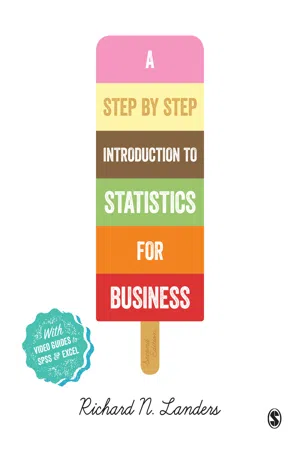
- 496 pages
- English
- ePUB (mobile friendly)
- Available on iOS & Android
A Step-By-Step Introduction to Statistics for Business
About this book
A clear and concise introduction to statistics for business and management students, demonstrating how important statistics are in the business decision-making process and covering everything from conducting a survey and collecting data, to summarizing statistical data, and presenting findings.
Each chapter features a real-world business situation and accompanying dataset, the reader is then encouraged to identify the correct statistical concept in the chapter and solve the problem outlined. Offering students a chance to use the newly learned theory in a practical way.
New to the second edition:
- A "Review of Essential Mathematics" prologue, featuring tests and further links to help students refresh their knowledge of the core mathematical concepts used to calculate basic statistics.
- Updated screenshots on using IBM SPSS and Excel.
- A "Statistics in the Real World" feature included at the end of each chapter, demonstrating how statistics are applied in real-world business settings and research, accompanied by reflective questions.
- Updated case studies, examples and diagrams, illustrating key points and helping to reinforce learning.
The book is accompanied byfree online resources including step-by-step video tutorials on how to use Excel and IBM SPSS, datasets and worked solutions, an Instructors' Manual, Testbank, and PowerPoint presentation slides for lecturers. Essentialreading for business students wanting to know how to use statistics in a business setting.
Frequently asked questions
- Essential is ideal for learners and professionals who enjoy exploring a wide range of subjects. Access the Essential Library with 800,000+ trusted titles and best-sellers across business, personal growth, and the humanities. Includes unlimited reading time and Standard Read Aloud voice.
- Complete: Perfect for advanced learners and researchers needing full, unrestricted access. Unlock 1.4M+ books across hundreds of subjects, including academic and specialized titles. The Complete Plan also includes advanced features like Premium Read Aloud and Research Assistant.
Please note we cannot support devices running on iOS 13 and Android 7 or earlier. Learn more about using the app.
Information
Part 1 Descriptive Statistics
1 The Language of Statistics
- How to describe data in a spreadsheet
- How to categorize variables by their scale of measurement
- How to identify whether variables are continuous or discrete, quantitative or qualitative
- How to identify a Likert-type scale
- How to specify a population and produce a sample from it
- How to identify constructs of interest and operationalize them
- How to identify experiments, quasi-experiments and correlational studies
Data skills you will master from this chapter
- Creating a dataset
- Identifying a dataset
- Navigating a dataset
- Specifying variable characteristics (SPSS only)
Case Study What Do I Do with This Spreadsheet?


1.1 Describing Numbers
1.1.1 Datum, Data and Datasets

Table of contents
- Cover
- Half Title
- Publisher Note
- Title Page
- Copyright Page
- Contents
- Acknowledgements
- Acknowledgments
- About the Author
- Your Guide to This Book
- Online Resources
- Preface
- Changes in the Second Edition
- Introduction
- Prologue Review of Essential Mathematics
- Part 1 Descriptive Statistics
- 1 The Language of Statistics
- 2 Working with Numbers and Data Display
- 3 Central Tendency and Variability
- 4 Probability Distributions
- 5 Sampling Distributions
- Part 2 Inferential Statistics
- 6 Estimation and Confidence Intervals
- 7 Hypothesis Testing
- 8 z-Tests and One-Sample t-Tests
- 9 Paired- and Independent-Samples t-Tests
- 10 Analysis of Variance (ANOVA)
- 11 Chi-Squared (X2) Tests of Fit
- 12 Correlation and Regression
- Part 3 Wrap-Up
- 13 Matching Statistical Tests to Business Problems
- References
- Appendix A
- Appendix B
- Appendix C Glossary
- Appendix D Statistical Notation and Formulas
- Appendix E Enabling Excel’s Data Analysis Add-In
- Index